Blimp1 defines a progenitor population that governs cellular input to the sebaceous gland
- PMID: 16901790
- PMCID: PMC2424190
- DOI: 10.1016/j.cell.2006.06.048
Blimp1 defines a progenitor population that governs cellular input to the sebaceous gland
Abstract
Epidermal lineage commitment occurs when multipotent stem cells are specified to three lineages: the epidermis, the hair follicle, and the sebaceous gland (SG). How and when a lineage becomes specified remains unknown. Here, we report the existence of a population of unipotent progenitor cells that reside in the SG and express the transcriptional repressor Blimp1. Using cell-culture studies and genetic lineage tracing, we demonstrate that Blimp1-expressing cells are upstream from other cells of the SG lineage. Blimp1 appears to govern cellular input into the gland since its loss leads to elevated c-myc expression, augmented cell proliferation, and SG hyperplasia. Finally, BrdU labeling experiments demonstrate that the SG defects associated with loss of Blimp1 lead to enhanced bulge stem cell activity, suggesting that when normal SG homeostasis is perturbed, multipotent stem cells in the bulge can be mobilized to correct this imbalance.
Figures
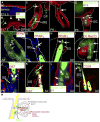
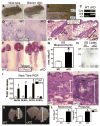
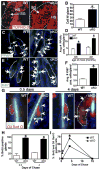
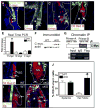
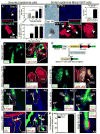
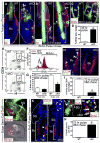

Similar articles
-
Characterization of bipotential epidermal progenitors derived from human sebaceous gland: contrasting roles of c-Myc and beta-catenin.Stem Cells. 2008 May;26(5):1241-52. doi: 10.1634/stemcells.2007-0651. Epub 2008 Feb 28. Stem Cells. 2008. PMID: 18308950
-
BLIMP1 is required for postnatal epidermal homeostasis but does not define a sebaceous gland progenitor under steady-state conditions.Stem Cell Reports. 2014 Oct 14;3(4):620-33. doi: 10.1016/j.stemcr.2014.08.007. Epub 2014 Sep 18. Stem Cell Reports. 2014. PMID: 25358790 Free PMC article.
-
Blimp1+ cells generate functional mouse sebaceous gland organoids in vitro.Nat Commun. 2019 May 28;10(1):2348. doi: 10.1038/s41467-019-10261-6. Nat Commun. 2019. PMID: 31138796 Free PMC article.
-
Have hair follicle stem cells shed their tranquil image?Cell Stem Cell. 2008 Dec 4;3(6):581-2. doi: 10.1016/j.stem.2008.11.005. Cell Stem Cell. 2008. PMID: 19041772 Review.
-
Lineage analysis of epidermal stem cells.Cold Spring Harb Perspect Med. 2014 Jan 1;4(1):a015206. doi: 10.1101/cshperspect.a015206. Cold Spring Harb Perspect Med. 2014. PMID: 24384814 Free PMC article. Review.
Cited by
-
The cell cycle regulator protein 14-3-3σ is essential for hair follicle integrity and epidermal homeostasis.J Invest Dermatol. 2012 Jun;132(6):1543-53. doi: 10.1038/jid.2012.27. Epub 2012 Mar 1. J Invest Dermatol. 2012. PMID: 22377760 Free PMC article.
-
Skin appendage-derived stem cells: cell biology and potential for wound repair.Burns Trauma. 2016 Oct 26;4:38. doi: 10.1186/s41038-016-0064-6. eCollection 2016. Burns Trauma. 2016. PMID: 27800498 Free PMC article. Review.
-
Dose and context dependent effects of Myc on epidermal stem cell proliferation and differentiation.EMBO Mol Med. 2010 Jan;2(1):16-25. doi: 10.1002/emmm.200900047. EMBO Mol Med. 2010. PMID: 20043278 Free PMC article.
-
Tracing the cellular dynamics of sebaceous gland development in normal and perturbed states.Nat Cell Biol. 2019 Aug;21(8):924-932. doi: 10.1038/s41556-019-0362-x. Epub 2019 Jul 29. Nat Cell Biol. 2019. PMID: 31358966 Free PMC article. Review.
-
Equal opportunities in stemness.Nat Cell Biol. 2019 Aug;21(8):921-923. doi: 10.1038/s41556-019-0366-6. Nat Cell Biol. 2019. PMID: 31358967 Free PMC article. Review.
References
-
- Alonso LC, Rosenfield RL. Molecular genetic and endocrine mechanisms of hair growth. Horm Res. 2003;60:1–13. - PubMed
-
- Arnold I, Watt FM. c-Myc activation in transgenic mouse epidermis results in mobilization of stem cells and differentiation of their progeny. Curr Biol. 2001;11:558–568. - PubMed
-
- Blanpain C, Lowry WE, Geoghegan A, Polak L, Fuchs E. Self-renewal, multipotency, and the existence of two cell populations within an epithelial stem cell niche. Cell. 2004;118:635–648. - PubMed
-
- Bull JJ, Pelengaris S, Hendrix S, Chronnell CM, Khan M, Philpott MP. Ectopic expression of c-Myc in the skin affects the hair growth cycle and causes an enlargement of the sebaceous gland. Br J Dermatol. 2005;152:1125–1133. - PubMed
Publication types
MeSH terms
Substances
Grants and funding
LinkOut - more resources
Full Text Sources
Other Literature Sources
Medical
Molecular Biology Databases

